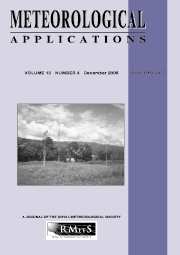Crossref Citations
This article has been cited by the following publications. This list is generated based on data provided by
Crossref.
Rusticucci, Matilde
and
Vargas, Walter
2002.
Cold and warm events over Argentina and their relationship with the ENSO phases: Risk evaluation analysis.
International Journal of Climatology,
Vol. 22,
Issue. 4,
p.
467.
Alessandro, A P
and
de Garín, A B
2003.
A study on predictability of human physiological strain in Buenos Aires City.
Meteorological Applications,
Vol. 10,
Issue. 3,
p.
263.
Rusticucci, Matilde M.
Venegas, Silvia A.
and
Vargas, Walter M.
2003.
Warm and cold events in Argentina and their relationship with South Atlantic and South Pacific Sea surface temperatures.
Journal of Geophysical Research: Oceans,
Vol. 108,
Issue. C11,
Bischoff, Susana A.
and
Vargas, Walter M.
2003.
The 500 and 1000 hPa weather type circulations and their relationship with some extreme climatic conditions over southern South America.
International Journal of Climatology,
Vol. 23,
Issue. 5,
p.
541.
Brikas, D. P.
Karacostas, T. S.
Pennas, P. J.
and
Flocas, A. A.
2006.
The role of the subtropical jet stream during heat wave events over north-central Greece.
Meteorology and Atmospheric Physics,
Vol. 94,
Issue. 1-4,
p.
219.
Norte, Federico Augusto
Seluchi, Marcelo Enrique
Gomes, Jorge Luis
and
Simonelli, Silvia Carmen
2007.
Análisis de una ola de calor extrema en la región subtropical de américa del sur.
Revista Brasileira de Meteorologia,
Vol. 22,
Issue. 3,
p.
373.
Cerne, S. Bibiana
Vera, Carolina S.
and
Liebmann, Brant
2007.
The Nature of a Heat Wave in Eastern Argentina Occurring during SALLJEX.
Monthly Weather Review,
Vol. 135,
Issue. 3,
p.
1165.
Basara, Jeffrey B.
Basara, Heather G.
Illston, Bradley G.
Crawford, Kenneth C.
and
Grimmond, Sue
2010.
The Impact of the Urban Heat Island during an Intense Heat Wave in Oklahoma City.
Advances in Meteorology,
Vol. 2010,
Issue. 1,
Cerne, S. B.
and
Vera, C. S.
2011.
Influence of the intraseasonal variability on heat waves in subtropical South America.
Climate Dynamics,
Vol. 36,
Issue. 11-12,
p.
2265.
Rusticucci, Matilde
2012.
Observed and simulated variability of extreme temperature events over South America.
Atmospheric Research,
Vol. 106,
Issue. ,
p.
1.
Rusticucci, Matilde
Kyselý, Jan
Almeira, Gustavo
and
Lhotka, Ondřej
2016.
Long-term variability of heat waves in Argentina and recurrence probability of the severe 2008 heat wave in Buenos Aires.
Theoretical and Applied Climatology,
Vol. 124,
Issue. 3-4,
p.
679.
Herbel, Ioana
Croitoru, Adina-Eliza
Rus, Adina Viorica
Roşca, Cristina Florina
Harpa, Gabriela Victoria
Ciupertea, Antoniu-Flavius
and
Rus, Ionuţ
2018.
The impact of heat waves on surface urban heat island and local economy in Cluj-Napoca city, Romania.
Theoretical and Applied Climatology,
Vol. 133,
Issue. 3-4,
p.
681.
Asakereh, Hossein
and
Shadman, Hassan
2018.
On the relationship between tropospheric conditions and widespread hot days in Iran.
Theoretical and Applied Climatology,
Vol. 131,
Issue. 1-2,
p.
805.
Collazo, Soledad
Lhotka, Ondřej
Rusticucci, Matilde
and
Kyselý, Jan
2018.
Capability of the SMHI‐RCA4 RCM driven by the ERA‐Interim reanalysis to simulate heat waves in Argentina.
International Journal of Climatology,
Vol. 38,
Issue. 1,
p.
483.
Alvarez, Mariano S.
Cerne, Bibiana
Osman, Marisol
and
Vera, Carolina S.
2019.
Intraseasonal and low frequency processes contributing to the December 2013 heat wave in Southern South America.
Climate Dynamics,
Vol. 53,
Issue. 7-8,
p.
4977.
Breeden, Melissa L.
Hoover, Brett T.
Newman, Matthew
and
Vimont, Daniel J.
2020.
Optimal North Pacific Blocking Precursors and Their Deterministic Subseasonal Evolution during Boreal Winter.
Monthly Weather Review,
Vol. 148,
Issue. 2,
p.
739.
Coronato, Tanea
Carril, Andrea F.
Zaninelli, Pablo G.
Giles, Julián
Ruscica, Romina
Falco, Magdalena
Sörensson, Anna A.
Fita, Lluis
Li, Laurent Z. X.
and
Menéndez, Claudio G.
2020.
The impact of soil moisture–atmosphere coupling on daily maximum surface temperatures in Southeastern South America.
Climate Dynamics,
Vol. 55,
Issue. 9-10,
p.
2543.
Bouniol, D.
Guichard, F.
Barbier, J.
Couvreux, F.
and
Roehrig, R.
2021.
Sahelian Heat Wave Characterization From Observational Data Sets.
Journal of Geophysical Research: Atmospheres,
Vol. 126,
Issue. 11,
Jacques‐Coper, Martín
Veloso‐Aguila, Daniel
Segura, Christian
and
Valencia, Amanda
2021.
Intraseasonal teleconnections leading to heat waves in central Chile.
International Journal of Climatology,
Vol. 41,
Issue. 9,
p.
4712.
Kamangar, Muhammad
and
Shadman, Hassan
2022.
The changes in the frequency of warm nights in Asia and the new climatic norms.
Theoretical and Applied Climatology,
Vol. 150,
Issue. 1-2,
p.
663.




